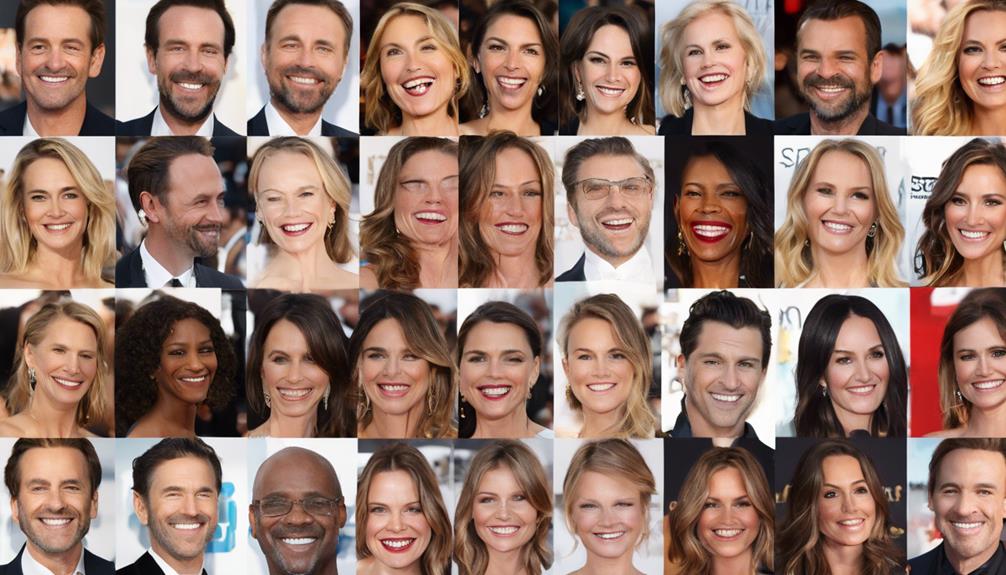Celebrities employ various body language tricks on the red carpet to project confidence and charm. Techniques like 'Eye Squinching' and 'Facelift Effect' enhance photos and define jawlines, exuding elegance. 'Eye Contact Power' and 'Smile Sincerity' uplift appearance by conveying charisma and approachability. Good posture, hand placement, and subtle gestures create a sophisticated aura. Techniques such as 'Elongating the Body' and 'Mirroring Body Language' foster trust and connection. 'Controlled Breathing' and 'Expressive Hand Gestures' manage nerves and engage the audience. 'Graceful Exit Techniques' leave a final warm impression. Celebrities master these tricks to enhance their presence on the red carpet.
Key Takeaways
- Eye squinching for confident photos.
- Facelift effect for a youthful appearance.
- Eye contact power exudes charisma.
- Smile sincerity enhances charm.
- Posture confidence and strategic hand placement.
Eye Squinching
Celebrities often employ the technique of eye squinching on the red carpet to enhance their photos and exude confidence. This subtle adjustment involves narrowing the eyes slightly and lifting the lower eyelids, creating a more intense and appealing gaze.
By squinching, celebrities can avoid looking wide-eyed or sleepy in pictures, ultimately helping them portray a more confident and engaging image to the public. This body language trick is particularly useful in the era of social media, where every photo can quickly circulate and leave a lasting impression on fans and followers.
Many celebrities have mastered the art of eye squinching to perfection, using it as a tool to elevate their red carpet appearances. This technique not only enhances their facial expressions but also adds a touch of sophistication to their overall demeanor.
Facelift Effect

When walking the red carpet, celebrities often employ a subtle yet effective technique known as the facelift effect. By gently pulling back their faces and elongating their necks, stars can create a more youthful appearance and define their jawlines in photographs.
This body language trick enhances their overall look, exuding confidence and elegance as they pose for the cameras.
Eye Contact Power
Engaging the camera with a confident gaze can instantly uplift one's appearance by creating a subtle facelift effect. When it comes to the red carpet, celebrities understand the power of eye contact in conveying charisma and confidence.
By maintaining eye contact with the camera, they not only exude a sense of self-assurance but also enhance their overall presence. This subtle yet effective body language trick is known as the 'facelift effect,' where pulling back slightly can define the jawline and neck, giving the appearance of a lifted face.
Celebrities use this eye contact power strategically to captivate audiences and photographers alike. Perfecting their gaze allows them to communicate without words, showcasing their charm and allure effortlessly.
On the red carpet, where every moment is captured and scrutinized, mastering the art of eye contact can make a significant difference in how one is perceived. It's a simple yet powerful technique that adds depth and magnetism to their public image.
Smile Sincerity
Creating a sincere smile with engaged eyes can significantly enhance one's charm and appeal in photos, contributing to the facelift effect desired on the red carpet. By engaging the facial muscles and allowing the eyes to convey warmth and authenticity, individuals can exude a genuine smile that radiates approachability.
The key lies in finding a balance between a natural smile and a relaxed facial expression, as this combination not only enhances one's overall appearance but also boosts confidence and charm in front of the camera. Celebrities often employ techniques such as 'squinching,' where they focus on smiling with their eyes to create a more engaging and sincere expression.
Experimenting with different variations of smiles can help individuals discover their most flattering and authentic look for various photo opportunities, ensuring they present themselves in the best light possible on the red carpet.
Posture Confidence
To exude confidence and achieve a facelift effect in photos, individuals can enhance their posture on the red carpet by pulling back their face slightly and elongating their body for a more youthful and defined appearance. Maintaining good posture not only conveys confidence but also adds an element of elegance to one's overall demeanor.
Celebrities always pay attention to their posture to make a lasting impression on the red carpet. Additionally, positioning one leg forward or to the side with toes pointing out can create a flattering silhouette and add a dynamic element to the pose, enhancing the overall look.
'Squinching' the eyes by narrowing them slightly is another trick celebrities use to give a more appealing and engaging look in photographs. Moreover, incorporating varied smiles, from subtle to radiant, can help convey different emotions and moods, ensuring a versatile range of expressions in red carpet photos.
Elongating the Body
Stretching their backs to appear taller and more elegant, celebrities on the red carpet employ body language tricks to elongate their silhouette for flattering photos. Lady Gaga, known for her bold fashion choices, often uses this technique to command attention. By pulling her face back slightly, she creates an instant facelift effect, giving a more youthful appearance. Positioning one leg forward or to the side with toes pointing out is another favorite trick of hers. This pose not only elongates her silhouette but also adds a flattering angle to her overall look.
Lady Gaga understands the power of creating an S shape with her body, enhancing her natural curves and creating visual interest. Additionally, crossing her feet when posing in short dresses helps her achieve a slimming effect and adds a touch of sophistication to her red carpet presence. These subtle adjustments in body language play a significant role in enhancing her overall image and confidence.
Smiling Variations

Celebrities strategically vary their smiles on the red carpet to achieve different photo effects and convey a range of emotions. Experimenting with different smile styles can help them project the desired level of confidence and approachability, while also adding depth and warmth to their overall expression.
Here are some smiling variations they often use:
- Closed-lip smile: This subtle smile exudes elegance and sophistication, perfect for more formal events.
- Genuine full smile: A wide, open smile can convey joy, positivity, and approachability, making it ideal for creating a friendly and engaging image.
- Smizing: By smiling with their eyes, known as 'smizing,' celebrities can add a touch of mystery and allure to their red carpet look.
- Controlled intensity: Adjusting the intensity of their smile allows celebrities to fine-tune the level of energy and enthusiasm they portray.
- Finding authenticity: Practicing different smiling variations helps celebrities discover the most flattering and authentic look for red carpet appearances.
Strategic Hand Placement

Strategic hand placement on the red carpet serves multiple purposes for celebrities. It can exude confidence through intentional hand gestures, signaling elegance and poise without uttering a word.
Additionally, subtle hand positioning can cleverly conceal any nervousness, allowing stars to maintain a strong and composed appearance throughout the event.
Confidence in Hand Gestures
Placing hands strategically during red carpet appearances is essential for celebrities aiming to exude confidence and control. Celebrities often use hand gestures to convey various messages without saying a word. Here are some ways in which hand gestures can help boost confidence on the red carpet:
- Power Poses:
Placing hands on hips or in pockets can convey power and assertiveness in photos, giving off a strong and confident vibe.
- Crossed Arms:
Crossing arms can create a sense of strength and authority in body language, showcasing a commanding presence.
- Facial Emphasis:
Hand placement near the face can draw attention to facial features and expressions, allowing celebrities to highlight their best features.
- Experimentation:
Celebrities experiment with different hand positions to find the most flattering and confident pose that suits their personal style.
- Non-Verbal Communication:
Hand gestures play a significant role in non-verbal communication, helping celebrities communicate confidence and poise without uttering a word.
Signaling Elegance and Poise
To exude elegance and poise on the red carpet, mastering the art of strategic hand placement is key for leaving a lasting impression. Celebrities often utilize specific hand positioning techniques to convey sophistication and grace during public appearances. By placing a hand on the hip or delicately holding a clutch, they add an element of refinement to their overall look. These subtle gestures can draw attention to certain features or accessories, enhancing the visual impact of their outfit.
Whether it's resting a hand on the waist or lightly touching the face, these actions create a sense of poise and elegance in photographs, capturing the essence of glamour. Through strategic hand placement, celebrities not only exude confidence and control but also elevate their body language, projecting a polished and sophisticated image on the red carpet.
The careful positioning of hands plays a significant role in enhancing their overall presence and ensuring a captivating and chic appearance.
Concealing Nervousness Subtly
Celebrities deftly use hand positioning techniques to discreetly mask nervousness while walking the red carpet. Placing their hands on their hips or in pockets helps create a powerful and confident stance, effectively concealing any signs of anxiety.
By subtly adjusting their hand positions, celebrities can give off an aura of ease and composure during the intense photo opportunities that come with red carpet events. This strategic placement not only diverts attention from any nervous habits or fidgeting but also aids in maintaining a polished and poised appearance throughout the event.
It's a commonly employed body language trick among celebrities, allowing them to exude confidence and grace as they face the cameras and the scrutiny of the public eye.
- Celebrities strategically place their hands on their hips or in pockets to conceal nervousness on the red carpet.
- Placing hands on hips helps create a powerful and confident stance, masking any signs of anxiety.
- By subtly adjusting hand positions, celebrities can appear more at ease and composed during photo opportunities.
- Strategic hand placement can divert attention from nervous habits or fidgeting, maintaining a polished appearance.
- This body language trick is commonly used by celebrities to exude confidence and poise while facing the cameras.
Shoulder Positioning

Frequently, celebrities strategically position their shoulders to convey confidence and approachability on the red carpet. By adopting an open and relaxed shoulder stance, they project an image of self-assuredness and ease, which can be enchanting in photos.
The way shoulders are held can greatly impact the overall body language signals they send out to the public. Adjusting the positioning of shoulders is a powerful tool that can instantly transform the dynamic of a pose, allowing celebrities to appear more commanding and influential.
The correct alignment of shoulders is essential in creating a strong and impactful red carpet presence. It isn't just about standing tall; it's about owning the space with poise and confidence.
Through subtle adjustments in shoulder positioning, celebrities can enhance their non-verbal communication and make a lasting impression on the red carpet. Mastering this aspect of body language can elevate their entire red carpet experience and leave a lasting impression on fans and photographers alike.
Head Tilt Techniques

When mastering head tilt techniques on the red carpet, a minor adjustment can greatly enhance a celebrity's overall presence and demeanor. Celebrities often use head tilts to create a more relaxed and approachable image, as well as to highlight flattering angles for their faces and necks in photos.
By tilting their heads, they can convey emotions like curiosity, interest, or engagement, adding depth to their poses. The angle of the head tilt plays a crucial role in setting the mood of a photo, allowing celebrities to switch between playful and casual vibes to more elegant and sophisticated ones.
Experimentation is key when finding the perfect degree of head tilt that complements one's facial features and outfit, ensuring a polished and photogenic appearance.
- Celebrities tilt their heads to appear relaxed and approachable.
- A head tilt creates flattering angles for the face and neck in photos.
- Tilting the head conveys emotions like curiosity and interest.
- The angle of the head tilt sets the mood of the photo.
- Experiment with different degrees of head tilts to find the most flattering angle.
Hip Angling

To create a more flattering silhouette and appear slimmer in photos, celebrities often use hip angling techniques on the red carpet. By strategically positioning their hips at an angle, stars can create the illusion of longer legs and a more defined waistline. This subtle adjustment not only enhances their physical proportions but also adds a touch of dynamism and interest to their poses.
The slight turn of the hips helps in breaking away from a static stance, allowing for a more engaging and visually appealing presentation on the red carpet.
Hip angling is a well-known trick in the celebrity playbook for enhancing posture and overall appearance during red carpet events. It's a simple yet effective method that contributes to the overall body language in photos, providing dimension and depth to their poses.
The strategic placement of the hips plays a crucial role in achieving a polished and sophisticated look that translates beautifully in images captured on the red carpet.
Perfecting the Red Carpet Stride

Mastering the art of the red carpet stride requires a combination of poise, confidence, and strategic body language techniques. Celebrities have honed their skills in this area, utilizing specific poses and movements to make a lasting impression as they make their entrance.
Here are some key strategies they employ:
- 'Double Teapot' Pose: Celebrities often use the 'double teapot' pose, where they place their hands on their hips while standing with their legs apart, projecting a sense of power and confidence.
- Open Shoulders: Keeping the shoulders open and relaxed helps create a strong and commanding presence on the red carpet.
- Head Position: Holding the head high and in alignment with the body conveys authority and charisma to onlookers.
- Pose Experimentation: Trying out different poses can help individuals discover the most flattering and impactful stride for their red carpet appearances.
- Walking Style: The way one walks and carries themselves on the red carpet can have a significant impact on their overall presence and image, making it an important aspect to perfect.
Confidence in Posture

Celebrities showcase confidence through their posture on the red carpet, standing tall with shoulders back and chin up. Posture is a key element in projecting confidence, as it conveys openness and self-assurance.
By adopting power posing techniques like the double teapot pose, celebrities are able to exude a sense of poise and authority, commanding attention as they make their grand entrance.
The impact of maintaining a strong and upright posture goes beyond mere appearance, influencing both how others perceive you and how you feel about yourself. A confident posture not only boosts self-esteem but also enhances your presence, making you instantly stand out in photographs and on the red carpet.
The way in which celebrities carry themselves through their posture speaks volumes about their inner confidence and self-belief, solidifying their status as icons of grace and charisma in the world of entertainment.
Mirroring Body Language

Mirroring body language subtly reflects the posture and gestures of others to establish rapport and enhance communication. This technique involves unconsciously imitating the nonverbal cues of the person you're interacting with, such as their body position, hand gestures, or facial expressions.
By mirroring these behaviors, individuals can create a sense of connection and understanding, leading to increased trust and comfort in the interaction.
- Mirroring helps build trust and connection by fostering a sense of similarity and empathy.
- Strategic use of mirroring in social situations can enhance communication and promote a positive atmosphere.
- It's vital to mirror subtly and naturally to avoid appearing insincere or mocking.
- Paying attention to cues like posture, gestures, and facial expressions is key to effective mirroring.
- Effective mirroring can lead to a smoother and more harmonious interaction with others.
Controlled Breathing

Controlled breathing plays a pivotal role in helping individuals manage their nerves and project confidence while handling the demands of the red carpet. Celebrities often utilize deep breaths to calm themselves, reduce stress, and alleviate anxiety before stepping into the spotlight. By implementing proper breathing techniques, they can control their heart rate, remain composed, and exude a sense of poise during interviews and photo opportunities.
This intentional focus on breathing not only aids in regulating emotions but also promotes a feeling of presence and concentration, allowing celebrities to navigate the red carpet with grace and elegance. Through the incorporation of controlled breathing into their routine, stars can project a relaxed and confident demeanor in front of cameras and fans, enhancing their overall body language and communication on the red carpet.
This simple yet effective strategy helps celebrities maintain their cool and appear collected in high-pressure situations, contributing to their polished and composed public image.
Expressive Hand Gestures

Utilizing expressive hand gestures adds a touch of sophistication and charisma to a celebrity's presence on the red carpet. Celebrities strategically employ hand movements to convey confidence and elegance, enhancing their overall demeanor.
These gestures not only add flair and personality to their red carpet poses but also serve as a non-verbal form of communication, allowing them to engage effectively with the audience.
Subtle hand gestures can draw attention to intricate accessories or details of their outfit, showcasing their style in a subtle yet impactful manner.
By mastering the art of hand gestures, celebrities can elevate their red carpet look and make a bold statement without uttering a word.
- Hand gestures convey confidence and elegance.
- They add flair and personality to red carpet poses.
- Celebrities use gestures to engage non-verbally with the audience.
- Subtle gestures highlight accessories or outfit details.
- Mastering hand gestures can make a powerful fashion statement.
Mastering the Profile Angle

Celebrities often rely on the profile angle pose to accentuate their best features and create a slimming effect on the red carpet. By slightly tilting their bodies to the side, with one shoulder forward and the other back, they achieve a flattering profile that highlights their curves.
Mastering this pose involves elongating the neck, lifting the chin slightly, and perfecting side glances to avoid a double chin appearance and showcase a sleek silhouette.
Flattering Pose Techniques
Flaunting their best features, stars often employ subtle body positioning tricks to master the profile angle on the red carpet. To achieve the most flattering pose, celebrities utilize various techniques that enhance their appearance in profile shots:
- Angling the body slightly to the side helps create a more flattering silhouette by accentuating curves and minimizing perceived flaws.
- The 'hip pop' technique involves pushing one hip slightly forward to add dimension and create a more dynamic pose that highlights the natural curves of the body.
- A subtle lean forward not only elongates the body but also adds an element of engagement and energy to the overall pose.
- By positioning one foot towards the camera and placing the other foot behind, celebrities create a visually appealing stance that not only slims the body but also adds interest to the pose.
- Avoiding standing straight-on to the camera in profile shots allows stars to showcase their best features and create a more interesting and dynamic pose that captivates the audience.
Perfecting Side Glances
To perfect their side glances on the red carpet, stars often employ subtle body positioning techniques that enhance their profile angles for striking and dynamic photos.
The profile angle, a popular pose choice among celebrities, serves as a sophisticated way to highlight their facial features and body silhouette. By slightly angling their body and face to the side, celebrities create an air of mystery and allure, drawing attention to specific attributes like the jawline or cheekbones.
This mastery of the side glance not only exudes confidence but also adds a layer of sophistication, leaving a lasting impact on the red carpet and in photographs.
The versatility of the profile angle allows celebrities to adapt the pose to different outfits and poses, enhancing the overall visual impact during red carpet events. With the right body language and positioning, stars can effectively showcase their best angles and make a memorable impression with their side glances on the red carpet.
Graceful Exit Techniques

How do celebrities master the art of gracefully exiting the red carpet with poise and charm? Celebrities employ various techniques to leave a lasting impression as they make their exit.
Here are some of the graceful exit techniques favored by celebrities:
- Shoulder shrug: By using the 'shoulder shrug' technique, celebrities can convey a sense of relaxation and ease as they depart the red carpet.
- Slow turn and wave: The 'slow turn and wave' pose is a popular choice among celebrities, exuding elegance and charm while bidding farewell to the cameras.
- Over-the-shoulder glance: Opting for an 'over-the-shoulder glance' adds a touch of mystery and allure to a celebrity's exit, leaving fans intrigued.
- Smile and nod: A simple yet effective technique, the 'smile and nod' allows celebrities to acknowledge their admirers and the paparazzi with grace.
- Blowing a kiss: Incorporating a 'blowing a kiss' gesture while exiting the red carpet helps celebrities leave a warm and appreciative final impression on their audience.
Frequently Asked Questions
How to Pose Like a Red Carpet Pro?
To pose like a red carpet pro, focus on projecting confidence and personality through deliberate body language. Experiment with various poses to find what suits you best. Perfecting your stance and positioning can elevate your overall appearance.
How Do Celebrities Get Ready for the Red Carpet?
Celebrities get ready for the red carpet by collaborating with stylists, perfecting hair and makeup, practicing poses, and engaging in workouts or beauty treatments. They focus on looking and feeling their best for the big event.
How to Pose in a Suit on the Red Carpet?
To pose in a suit on the red carpet, one should stand with even weight distribution, hands in pockets or on hips, shoulders back, and wear a well-tailored suit for a powerful and polished look. Experiment with poses for comfort and flattery.
How to Pose on Carpet?
Want to nail your red carpet pose? Strike a power pose like the double teapot for confidence. Experiment with different poses, keep it dynamic, and avoid holding one pose too long. Showcase your best self!
Conclusion
To sum up, mastering body language tricks can make a big impact on the red carpet. By utilizing techniques such as eye squinching, strategic hand placement, and graceful exit techniques, celebrities are able to exude confidence and elegance.
These subtle gestures can truly enhance their presence and leave a lasting impression on the audience. Remember, it's not just about what you wear, but how you carry yourself that can make all the difference in the spotlight.









